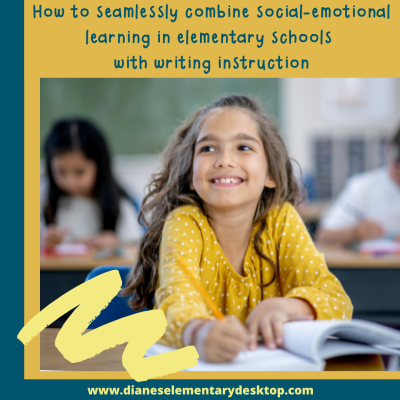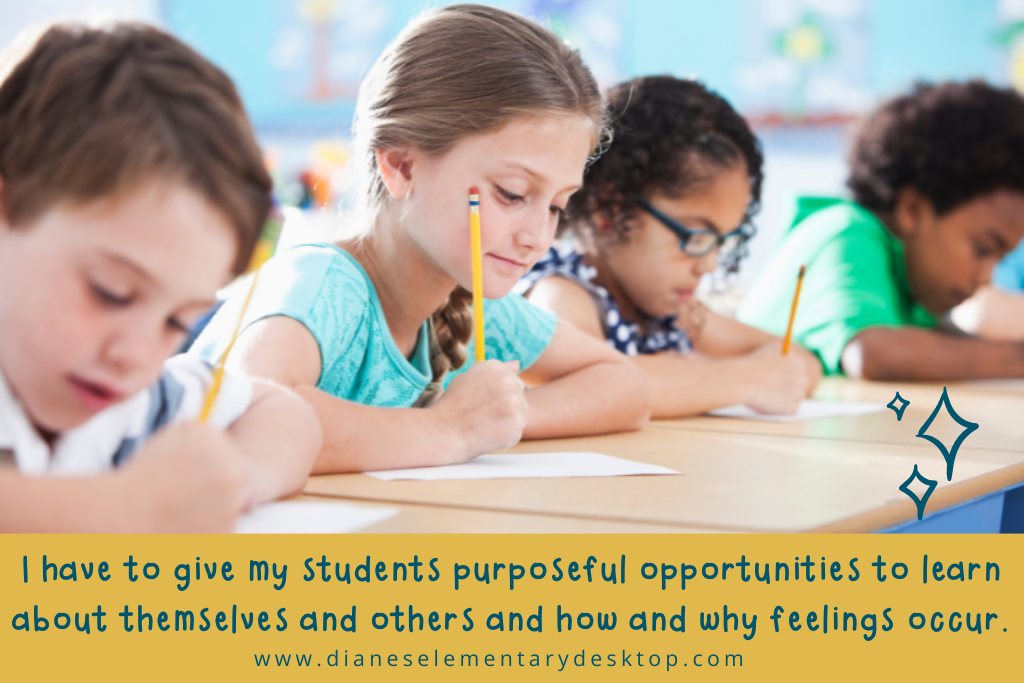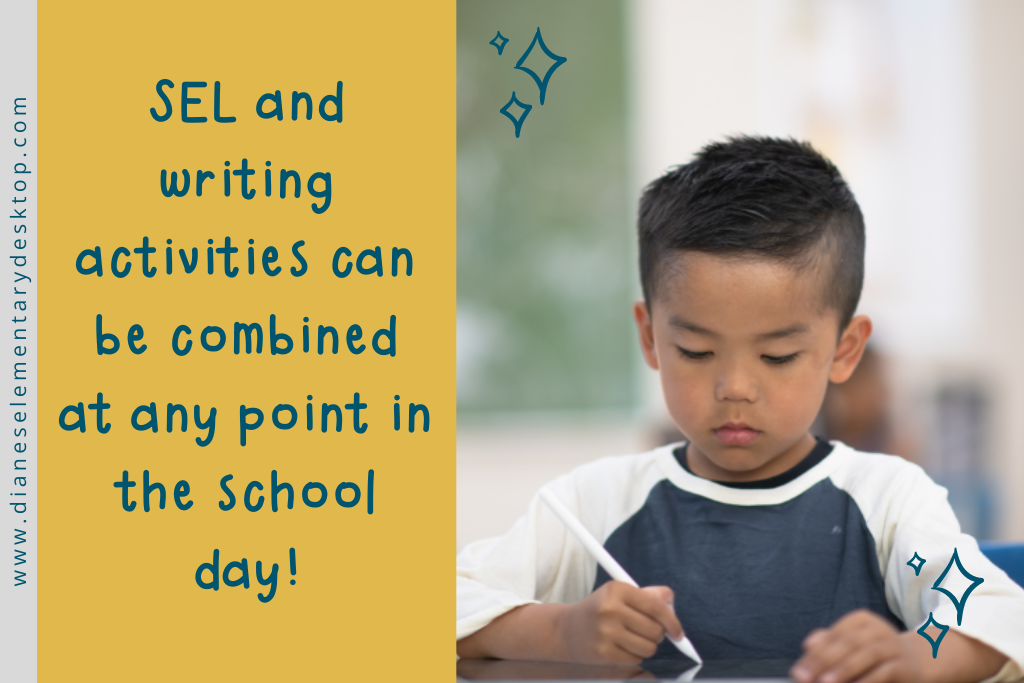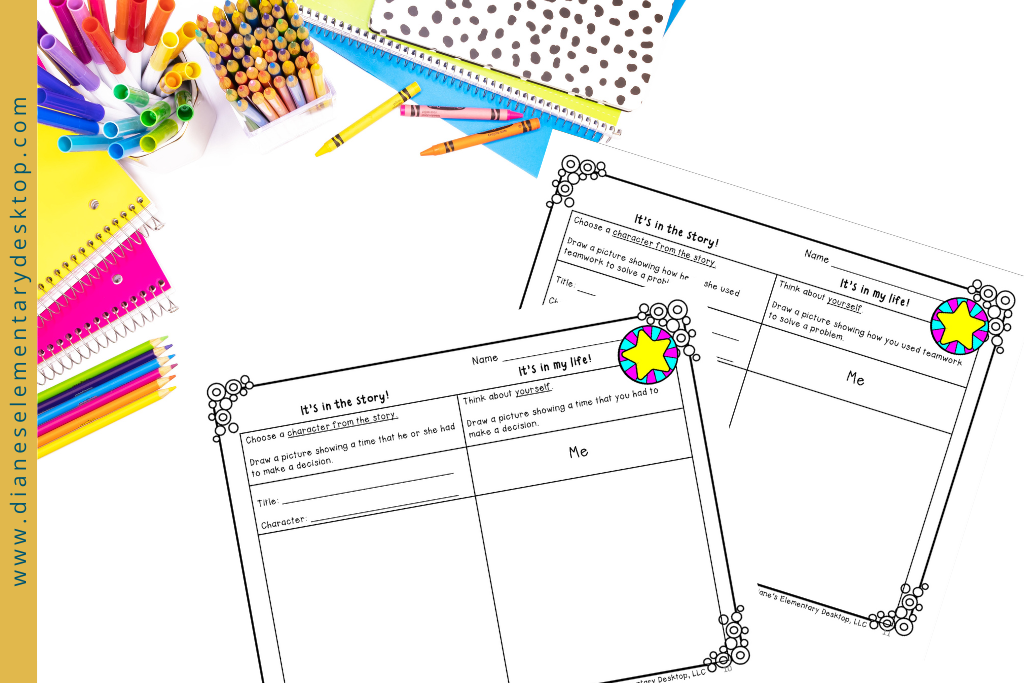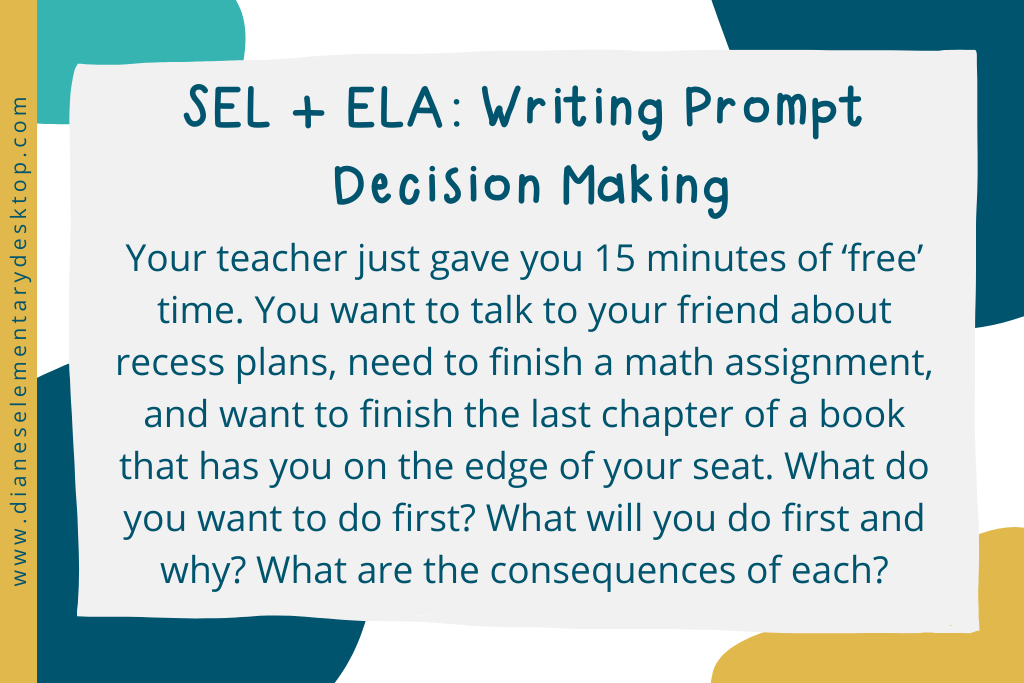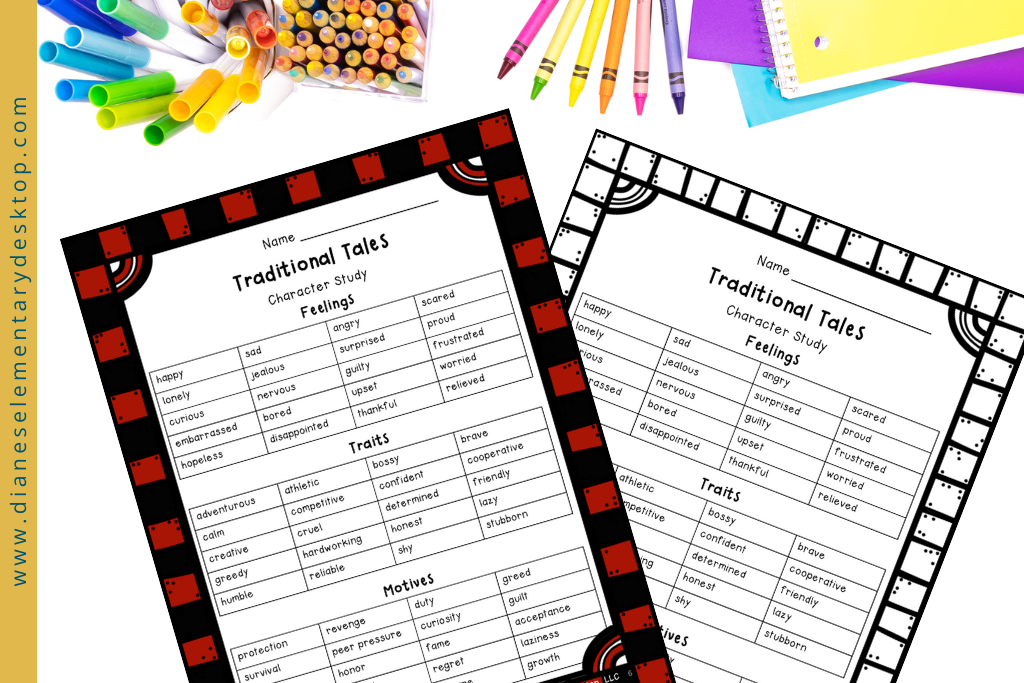Social emotional learning in elementary schools often abbreviated SEL, occurs in every classroom every day. Teachers are constantly helping their students learn about themselves and others. Read my blog post to find out more about social emotional learning. SEL lessons can occur formally or informally and assist our students in learning about themselves, others, and responsible decision-making.
CASEL (Collaborative for Academic, Social, and Emotional Learning) has identified five competencies of social-emotional learning. They include self-management, self-awareness, social awareness, relationship skills, and responsible decision-making. Teachers help their students learn these skills throughout the school day! I believe that SEL learning activities are crucial and can make a huge difference in how the school day goes for everyone. In fact, when we purposefully weave these activities into our instruction, teachers and students can reap the rewards! Weaving these activities into our writing activities offers students an opportunity to learn about themselves and others and can have far-reaching effects on behavior throughout the day.
Before getting into combining social-emotional learning and writing opportunities, I have some quick ways for combining SEL and ELA so you can get started right away! I’m a teacher and Reading Specialist with over 20 years of experience in elementary schools, who learned the importance of SEL and wanted to find more time and more ways to incorporate this learning for my students. That’s why I’ve created my FREE guide called “How To Seamlessly Combine Social Emotional Learning Opportunities With English Language Arts Instruction.” I want you to see how easy it can be to combine SEL and ELA, save time, and give your students more of what they need. Click here to get it right away and launch newly-found learning opportunities for your students!
Social emotional learning example
Today’s elementary classroom with its buzz of students, lengthy teacher to-do list and enormous responsibilities is like nothing else. Our students rely on us for more than just reading and writing instruction. Whether they know it or not, our students need us to help them learn how to be good humans! As a classroom teacher like you, I experience this firsthand.
Before I can teach reading and writing, I have to gauge emotions and make sure my students are ready. Body language speaks volumes and I have come to learn, depending on the student, if I should give him or her some quiet time or if I should engage in a conversation and try to figure out how they are feeling and why they are feeling this way. I have to constantly find ways to let my students express their emotions. Beyond that, I have to give them purposeful opportunities to learn about themselves and others and how and why feelings occur.
I talk to my students one-on-one or in a small group when feelings are hurt or someone is upset. Social emotional learning occurs within these conversations. As students work through their emotions and find ways to move through situations that are upsetting, they are learning about themselves and others. Putting these ideas on paper allows you to combine social emotional learning and writing.
Read this if you’re asking, “How can I combine SEL with writing?”
I write with my students every day and know it is a skill that needs to be developed. We use our curriculum and teach the standards so our students are proficient writers who can clearly communicate their important ideas. Because our students need to be writing every day and because we need to provide social-emotional learning opportunities, combining the two is not only an efficient but an effective use of time. Students think about their own lives and are given a voice to express important feelings. Giving students time to share their writing (if they’d like) is another way to validate how they’re feeling.
Social emotional learning in the classroom
- Most importantly, social emotional learning in elementary schools can be combined with writing activities at any point in the school day! Use as activators or summarizers during a reading or writing lesson, as brain breaks, for morning or dismissal work, during transition time, or anytime you can think of!
- Writing can take place in the form of both pictures and words. Depending on the levels of students in your classroom this is an easy way to differentiate and meet students where they are. Providing blank or lined paper gives students an opportunity to express how they’re feeling when they come into the classroom or at any point in the school day.
- Journal writing is often just what’s needed to express feelings or reflect on a situation. In fact, students can keep a composition book or spiral notebook in their desks for this purpose.
- Providing writing prompts narrows the focus and gives you insight into something more particular. Try these Back to School Writing SEL activities any time of the day!
- Provide opportunities for your students to learn individually, with a partner or small group, or during whole group time. Students can brainstorm, talk through ideas or share their writing and learn from others.
- ELA and SEL skills taught hand-in-hand can help students make connections and have deeper learning. Check out this FREE Traditional Tales Visualizing activity as an example.
Social emotional learning writing prompts
Give writing prompts any time of the day. In addition to your writing block time, use them for morning work, brain breaks, for early finishers, or during transitions. Provide SEL topics that your students need to think about or topics that you pre-planned. Give them time to free-write without any instruction or ask for certain things that their writing must include (for example, a main idea and three details or a beginning, middle, and ending.) Writing prompts can ask about decision-making, including why they made a certain decision, and the consequences that followed. Here is an example of an SEL writing prompt:
Your teacher just gave you 15 minutes of ‘free’ time. You want to talk to your friend about recess plans, need to finish a math assignment, and want to finish the last chapter of a book that has you on the edge of your seat. A writing prompt can help students sift through these options by asking thought-provoking questions.
Self management is the ability to
Self management is the ability to effectively manage emotions and behaviors in certain situations. Our students come to school having had different opportunities to label and manage their emotions and behavior. Some students can tell us they feel happy, sad, or frustrated. Others may express these feelings through behaviors but not really know where the behaviors are coming from. Give labels for emotions and examples of why someone might feel this way. Taking it further by analyzing characters’ feelings, traits, and motives will help students not only understand themselves but can help with self management. Here is a FREE list of feelings, traits, and motives that can be posted with a writing prompt after a read-aloud or as a class reflection on relationships or decision-making skills. You are on your way to combining SEL and ELA!
Determining and writing about goals
Having a clear goal in mind helps us take manageable steps toward achieving it. Taking time to help students articulate goals can be a great way to combine SEL and writing. Provide a list of personal and academic goals your students might want to work on. Personal goals can be in the form of behavior management, organization, or relationships. Academic goals might include work completion, time spent reading, or writing stamina. To start, you might want to pick something your class can work on together. Choose a goal and determine the steps needed to achieve it. A writing prompt can ask students to write about why this goal is important, obstacles to achieving it, or the effects of achieving the goal.
Text structure and learning about others
An important social-emotional skill for students to practice and learn is recognizing similarities and differences in others and building positive relationships. What does this have to do with text structure? Here’s where we get an amazing opportunity to help our students form connections. Use a Venn diagram when teaching compare and contrast. First, as an activator, supply a Venn diagram and ask students to compare and contrast themself to someone else in their life. Then, use a Venn diagram as part of the reading lesson. Read a story and have students compare and contrast characters with the Venn diagram. Using the same graphic organizer will help students form connections on what it means to compare and contrast.
Main idea and details can also be taught hand-in-hand with social-emotional learning. Give students an SEL topic as the main idea and ask for three details to describe or support it. Examples are: ways to work effectively in groups or how to contribute to the school community.
Main Idea and Supporting Details Graphic Organizers With SEL Activities can help you start combining the text structure of main idea and SEL right away. Use with any text to help students learn about this important text structure and themselves, others, and decision-making.
Decision-making and writing
I’ve seen reflection opportunities that students are given after they’ve done something they shouldn’t have. Students write about why they did it and what they could do next time instead. In certain circumstances, this might be just what’s needed. Sometimes I worry that students might connect writing to getting in trouble so I was often hesitant to do this with some students.
How can decision-making and writing be combined? If your focus is an SEL lesson, you can start by brainstorming decisions that students make each day. Or, if that seems like a lot, narrow the day down to decisions made at school or decisions made in the morning at school. Through the discussion, they’ll probably realize that some things they get to choose and others things they just don’t, but that’s okay. When discussing things that they do get to choose, take it further and discuss how their decisions affect themselves and others.
Example of social emotional learning in elementary schools
Social-emotional learning in elementary schools can be combined with writing at any time of the day. I can get you started right away!
- As students walk into the classroom in the morning, have them choose from a list of emojis how they’re feeling. For morning work, they can draw the emoji and then write about why they are feeling that way.
- Ask students to identify something they’re really good at (a strength). Then they can write about how that strength can benefit both themselves and others.
- Discuss personal or academic goals. Have students choose a goal and write about the steps they will take to achieve it.
- If there’s a difference of opinion between students, ask them to reflect on how they’re feeling with a drawing or writing. They can then share it with a partner or small group. It is important they are able to share their feelings and also listen to how others are feeling.
- Teach students how to make decisions whenever they have a choice. Stop, be calm, identify the choices, consider each option, make your choice, reflect. Then, students can write about this process and reflect on how it went and its consequences.
Benefits of combining SEL and writing
Combining social emotional learning in elementary schools with writing opportunities can have many positive effects. From labeling emotions to setting goals to responsible decision-making, social-emotional learning can take place throughout the day. Give students time to both think and write about these important discoveries. Why do they feel a certain way? How does this relate to a decision they made? What are the effects? Combining SEL with ELA through read-alouds and writing can help our students form deep connections with the content and improve behaviors in the process.
Check these links out for some more great information on combining SEL and writing opportunities!
How Can We Use Writing Time To Nurture SEL Skills?
Integrating SEL Into Writing Instruction
Journaling as a Social Emotional Learning Practice
I have come to realize how very important it is to provide social-emotional learning opportunities in the classroom. It will never be enough to just teach reading and writing. We have to support the whole child. If you need some more ideas on how to combine social-emotional learning and English language arts, download my FREEBIE today, “How To Seamlessly Combine Social Emotional Learning Opportunities With English Language Arts Instruction.” You’ll learn ways to save time, teach important life skills, and teach important ELA skills! In the end, combining ELA with social emotional learning in elementary schools is a great way to support our students!

